- Home
- Cooking
- Roasting
- Frying
- Stir Frying
- Braising
- Steaming
- Baking
- Marinating
- Grilling
- Candy Making
- Deep-Frying
- En Papillote
- Curing
- Glaze
- Skewers and Kebabs
- Infusion
- Juicing
- Gravies and Sauces
- Making Pasta
- Outdoor Cooking
- Poaching
- Reduction
- Sautéing
- Soups and Broths
- Preserving Methods
- Fondue Methods
- Pané Methods
- Making Stocks
- Making Bread
- Griddling Methods
- Savoury Bakes
- Stews
- Making Salads
- About Cooking Crashes
- My Man's Cooking
- Patés and Terrines
- Roasting Meat
- Gardening
- Recipes
- Cakes and Bakes
- Fish
- Desserts
- Soups
- Stir Fry
- Meat
- Starters
- Snacks
- Smoothies
- Brunch
- Savoury Pies
- Vegetarian
- Salads
- Pasta
- Rice Dishes
- Picnic
- Stews
- Jams and Chutneys
- Burgers and Meatballs, Vegballs and Fishballs.
- Festive Recipes
- Sides
- Breakfast
- Pizza and Tartiflette
- Lunch
- BBQ and Grill
- Savoury Bakes and Gratins.
- Fondues
- Raclettes
- Leftover Recipes
- Sauces, Vinaigrettes, Dressings and Dips
- My Recipes
- Seasonal
- Tips
- Ingredients
- Cheese
- Fruits
- Vegetables
- Meat
- Fish
- Eggs
- Breads and Bakes
- Spices
- Herbs
- Sauces, Pastes and Stocks.
- Nuts
- Dairy
- Condiment
- Seaweeds
- Baking Ingredients
- Seeds
- Pastas and Noodles
- Pastries and Batters
- Shellfish and Seafood
- Oils, Vinegars and Cooking Fats
- Leaves
- Preserved Food
- Snacks
- Stuffing and Mincemeat
- Edible Succulents
- Edible Flowers
- Tofu
- The Unusual Delicacies.
- Honey
- Rice
- Sommelier
- Pets
- Wildlife
- News
- Reviews
- About
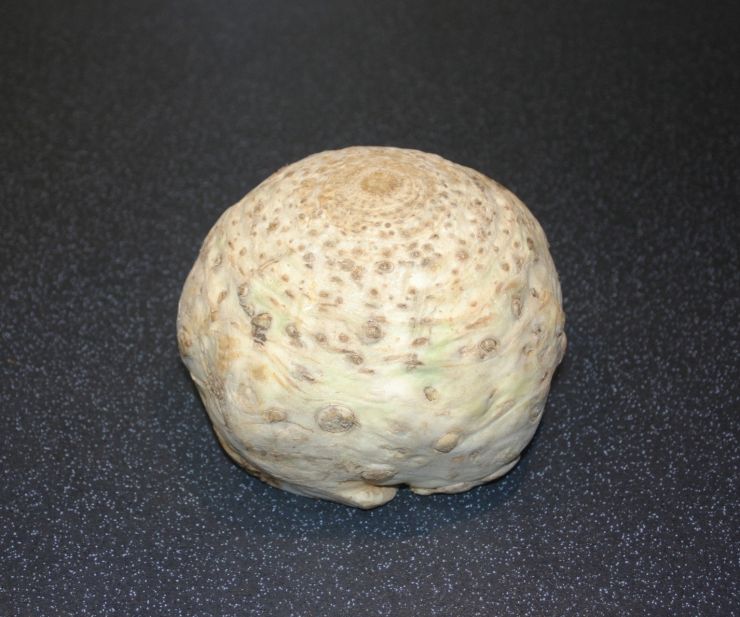
On the twenty first of December, we do have the Winter Solstice therefore we can say it is fully Winter. From the abundance of the three other Seasons, we may think that we can face a great lack in Winter. It can be so but It also can be otherwise since we did learn from the past and our ancestors. We do know how to preserve food but also what is growing and ready to harvest during this month of the year.
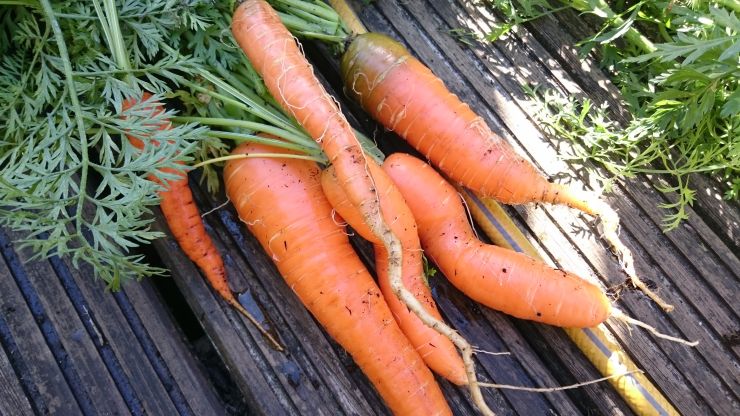
Carrots are one of the many Vegetables available during Winter.
What I am about to say doesn't apply to every part of the World but mainly to the Northern Hemisphere. The matter of fact is, it is just from my own experience. With a grin I will say that we usually have Brussels Sprouts on Christmas day: Why? Because they are in season at this time of the year. Hating them or loathing or liking them, they are available in December. Whatever you are doing with them is up to you. The tradition of criss crossing them on the bottom have moved on slightly so is the one to boil them to a bitter death.
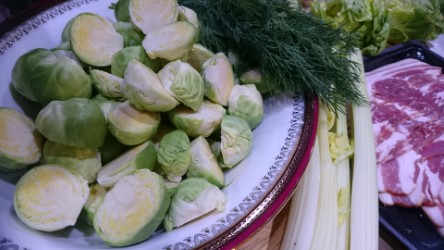
Brussels Sprouts ready to be braised.
There are so many ways to cook that little in Season Cabbage: From Stir Frying to Braised passing by to Roasted. My preference is to braise them. With a little trim (the base), removing of the damaged outoor leaves, quartered or halved the Brussels Sprouts will be prepared to be cook in your favourite way. There it is in your power to be creative with the old Sprouts. I will say there, that the World is your Oyster in a certain extent.
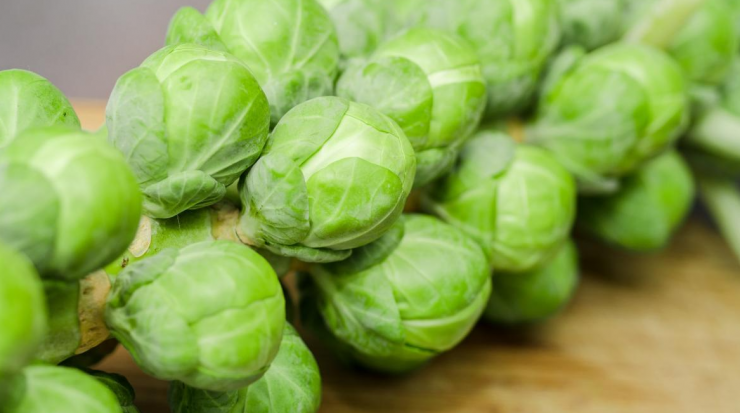
Brussels Sprouts are not very liked but always sought for during the Festive period.
Some Butter in a pan, a little Oil for the Butter to not burn, chopped Shallots, chopped Garlic, can be a good start to cook the Sprouts. Add with them some chopped Celery and chopped Bacon or Lardons and let the entire lot to golden a little bit. Other additions could be chopped Carrots which is also a Vegetable available in December. Then you can deglaze the pan with a tiny bit of Sherry or else White Wine ( If you can't drink it, don't use it, Keith Floyd said). Pour a little Stock to finish to cook the entire dish. The choice is entirely yours in terms of Stock, a Chicken one or a Vegetable one works well with it all but a Ham one can do so just as well. Reduce the heat and let it simmer nicely. It is not the longer the better venture there. To have a bite within all the elements can be pleasurable. But give or take I will say half an hour to forty five minutes for best results. Other additions can be added at the very last minutes or as decoration and for texture: your own choice of Nuts may it be Walnuts, Chestnuts or Hazelnuts (chopped). Then Herbs would not go amiss: Chopped Parsley, Chives or even Dill. You will end up with Brussels Sprouts which may be crucified in a nice way.
When we are speaking of Winter Vegetables, the Root ones spring into mind mainly. We are in the world of Celeriac, Carrots, Beetroots, Parsnips, Turnips, Horseradish, Swede... and the very last Potatoes of the year. To think about it, it is far from being deadly and dreary. First of all I do like my Carrots and my Parsnips then when they are Roasted and Honey glazed, it is bliss in the palate. My palate becomes a palace.

Parsnips are one of my favourites roots Veg.
To root for the Roots even further I will say something about Turnips and Swede. In Winter time, a good Stew is likely to be on the Menu. It is a pick me up Dish and warm my belly and body up kind of thing. It does wonders. Therefore the cheep and cheerful Turnips and Swede have my thumbs up all the way.
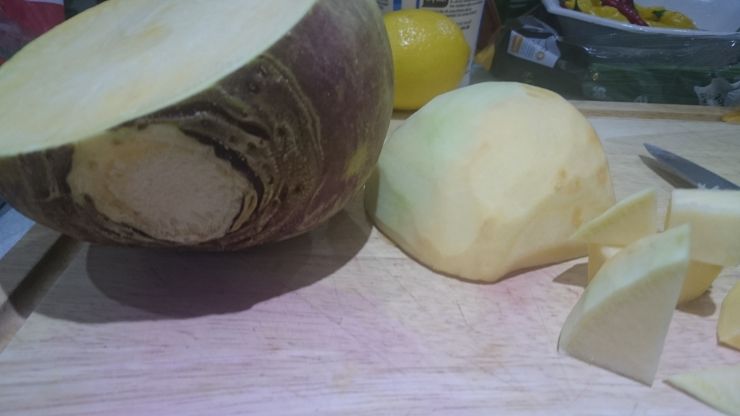
Swede can be a large Veg to tackle with but it can be done to bring some flavour to a Stew.
To be honest I wasn't a great fan of Celeriac until I tried it in different manners, from Sautéed, to Purée to Salt Baking. Then it did click with me a little more. A Celeriac Soup is a great number to add to your repertoire for the Winter Months with gratted Truffle for taste and decoration, chopped Chives and some Cubetti di Pancetta. It does elevate that subtle Veg to the next level, however, if you just swap the Truffles for Chestnut Button Mushrooms nicely sliced, get some Lardons into a small frying pan with them, a little chopped Garlic and a sliced Leek, you will have a very nice Comforting Soup in the end by garnishing your Celeriac Soup with them.
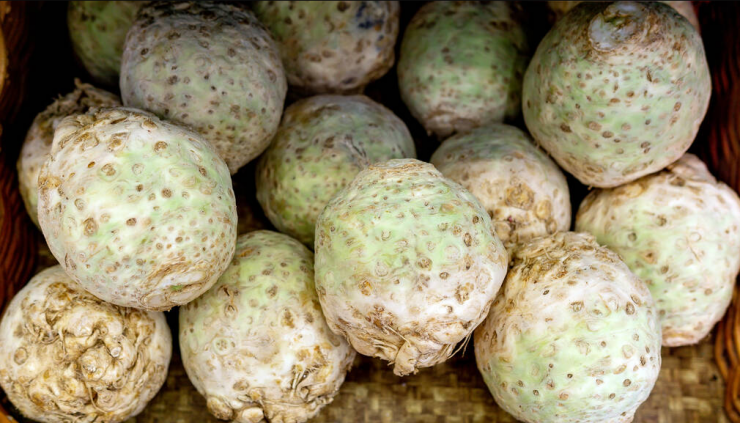
Celeriac are not the prettiest of Vegetables by all means but they do constitute the mean for a very decent side to a dish. Celeriac Mash is lovely with Fish then a Celeriac Creamy Dauphinoise is worth a try.

Creamy Celeriac Soup with Chives and Bacon is worth a try.
To mention another Root available in Winter, one can't forget the Beetroot for the stains it leaves behind. Personaly I am a big fan of pickled Beetroots. It is one of my go to little treats. You know the one that you can't help to dive into once a jar is opened. Cubed, sliced, crinckled, I don't mind anything when a Beetroot is pickled. Pickling that Veg in my opinion is an art form because then it can be enjoyed throughout the Winter and many more months. If I do enjoy pickled Beetroots I also do love cooking with them despite the stains.
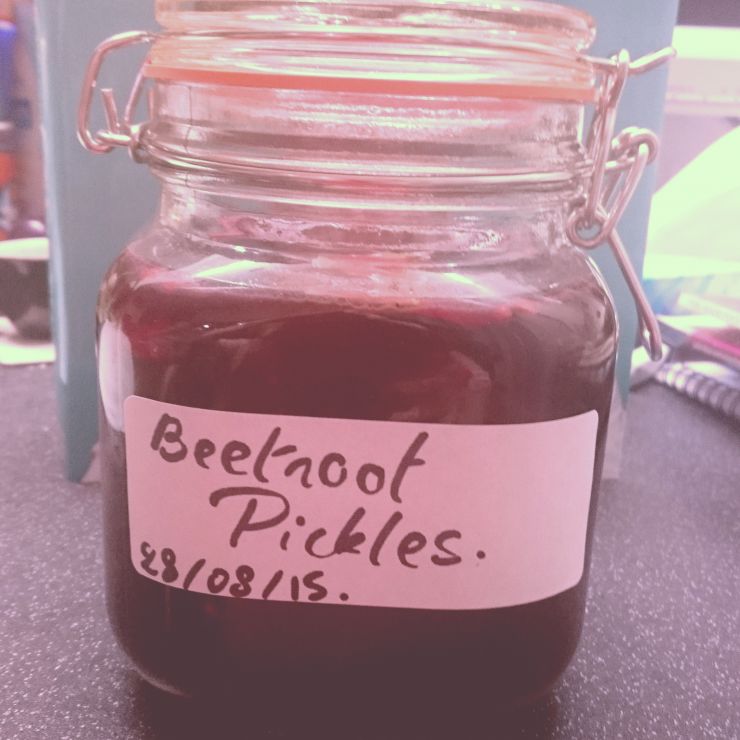
It is always nice to have pickled Beetroots in the pantry during the cold days.
There are of course more ways to get the most of Beetroots which is a fabulously tasty Veg in my books. I do like roasting them, but either in Winter or Summer do Soups with Beetroots. Hot Soups in Winter and Cold Beetroot Soup in Summer.
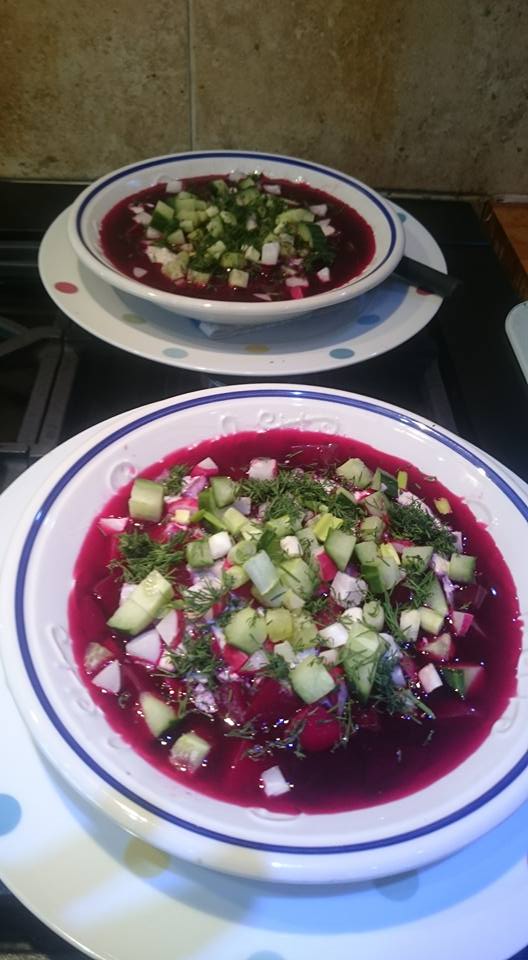
Beetroot Soup with Cucumber, Dill, Radishes and an Horseradish creamy sauce to pour over it. It leaves behind a very purple but happy tongue.
As a Root Vegetable, like so many of them, Beetroots are versatile to deal with and to use. They are also not very hard to grow given the space. They do come in many varieties therefore many colours hence it is not only with their taste that they can enhance a Dish but also their look.

Dealing with Beetroots can be a messy job, a colourful one if I may say but I will add a very rewarding one, from growing to cooking, passing by using them in one way or another.
Another Root Vegetable ripe and ready in the Winter months is one that can warm your mouth straight away: The Horseradish. Strangely enough its taste goes well or balance the sweetness of the Beetroot which we did mention above. Both in season and both are a match. From the Radish Family, the Horseradish is peppery and pungeant, more than a Radish but slightly less than the Wasabi. Lets just say that it gives you a kick.
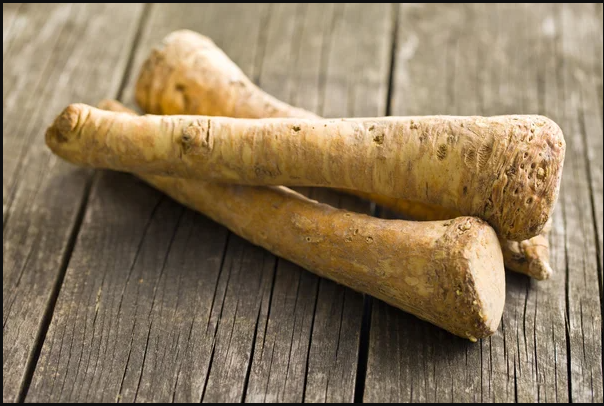
Horseradish does look like Parsnip but a bite of it will tell you the difference.
From all the Horseradish Sauces, I do prefer the Creamed one, but it is only because I am Asthmatic, for I do love the hot taste of Horseradish. In this house we use them in a rather traditional way as a condiment such as we would do with Mustard. A Horseradish Sauce goes hand to hand with a nice Roast Beef or its leftover.
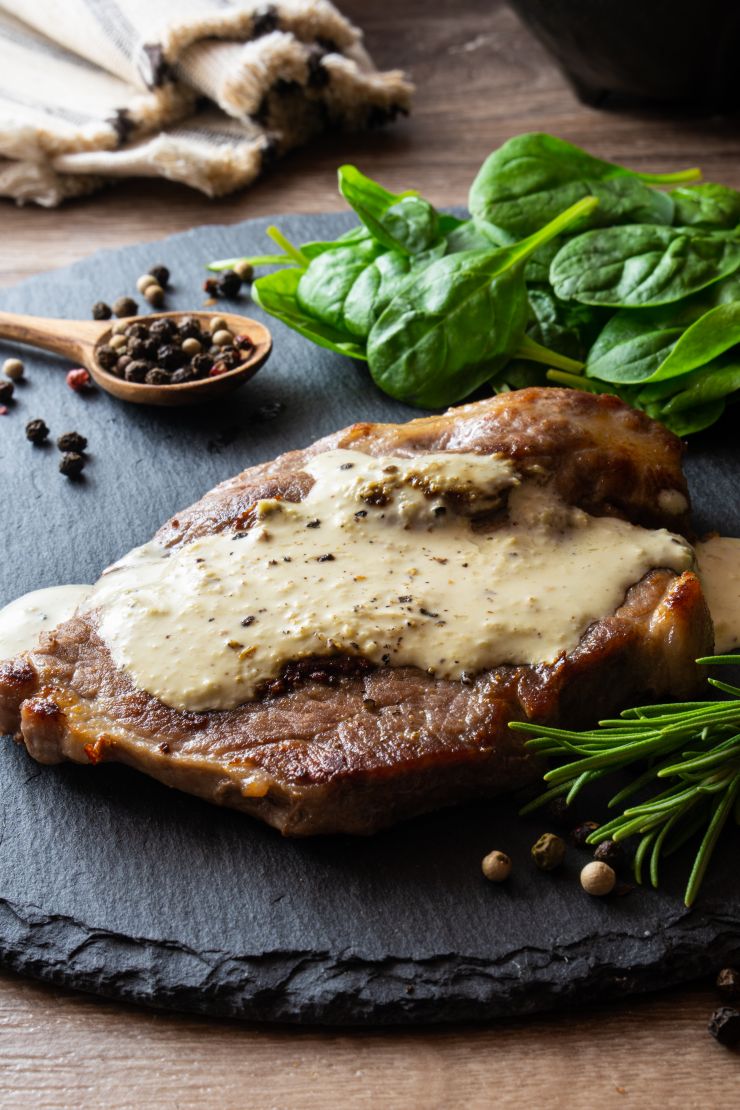
Horseradish Sauce with Peppercorn upon a Beef Steak.
We mentionned a lot about Root Vegetables but even in Winter we do have access to some of the above the ground ones. I will start by the Brassicae Family. Brussel Sprouts being a very traditional one, we must not forget about the other Cabbages. Kale is easy to grow and can be harvested in Winter. Kale leaves make a substential side to any main course or to be part of one. I usually use mines as part of a good Stir Fry.
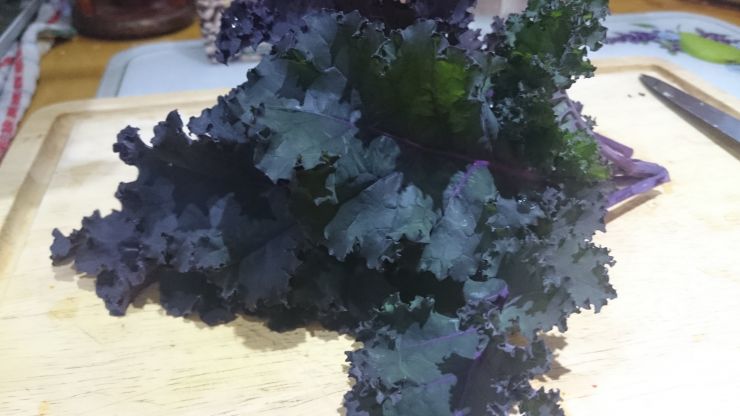
Purple Curly Kale from the Garden.
The Varieties of Kale are I would say 'Giganticus'. It is as if you were saying 'Bob is your Uncle and...'. They are plenty to choose from for your own taste. Every year I am growing some but all the time a different kind from lack of space but also for the purpose of giving a try to a new variety.
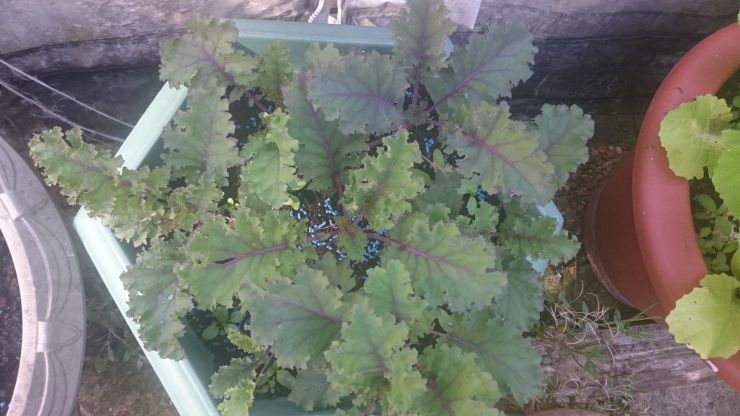
Curly Kale in a pot far back in my early gardening days.
Hardy, the Kale is an excellent December Vegetable which compliments many other ones or can accompany the likes of Squashes of different varieties by braising or roasting. It can create either a wonderful side or a very nice Veggie Main.
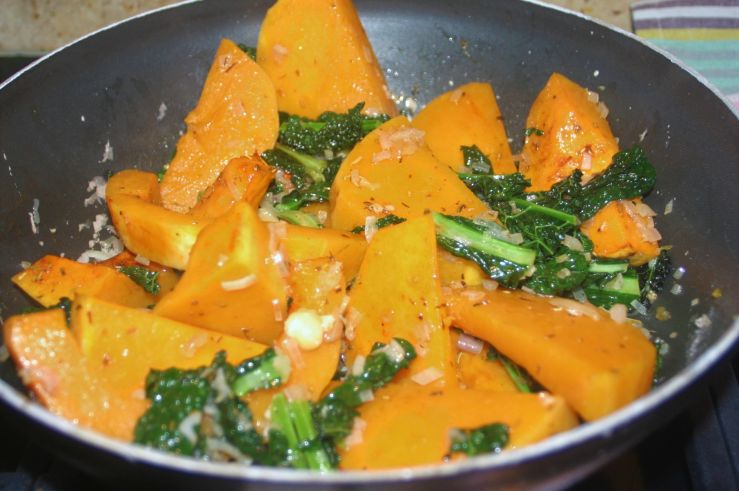
Sautéed Butternut Squash and Kale, with chopped Shallots and chopped Garlic. Either cracked Szechuan Pepper or a chopped Red Chilli, deseeded or not, do help to lift the dish to another level: the warm meal for Winter days.
Cabbages in general are available throughout Winter (depending on the weather), but they are also very versatile in terms of culinary use. Shredded or chopped, Cabbages can make a good base for Gratins or Bakes and Soups (Ramens), but their leaves can also be used as an envelope, a wrap to be stuffed with Mince or else.
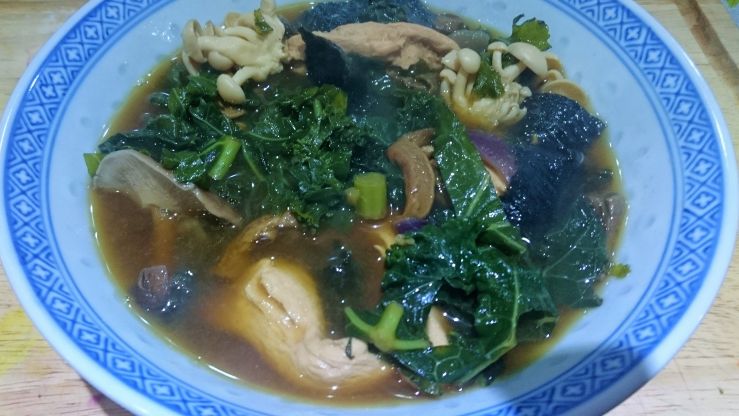
Kale and Mushrooms Ramen. This was a nice Soup for the Winter.
During the cold months of the year I tend to turn to Soups almost naturally or by instinct. But also because I do have problems with swallowing it is making it easier for me to eat, nowadays. If we do go back to our good old friend the Brussels Sprouts, a nice Soup can be made out of those just as well as with Kale.
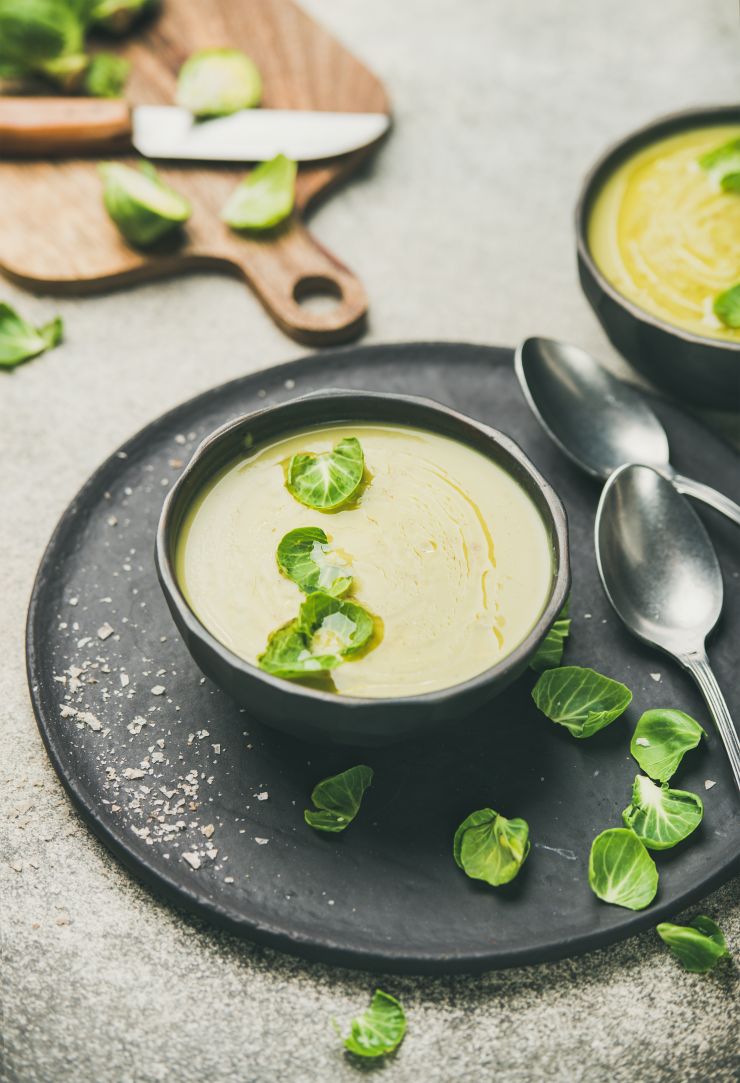
Brussels Sprouts Soup.
Winter Veg are usually perfect for making Soups which is great. A mix of shredded White Cabbage and Savoy Cabbage, a large finely chopped White Onion, one Garlic Clove (either chopped, grated or crushed), one chopped Celery Stick and one Carrot gently rendered in Butter can be the base of a very good Soup. Add a little White Wine along with Chicken Stock or Vegetable Stock then simmer for a good half an hour. Depending on your dietery choices this Soup can easily be twicked. I like mine creamy but not to thick, therefore I do pour Single Cream to give it a velvetiness which is comforting in Winter. Seasoning is important, Cracked Black Pepper and Sea Salt to adjust the taste but also while the simmering is being under way, a Bay leaf or two dropped in the pot will give an aromatic flavour. A pinch of powedered Nutmeg can also be considered for warmth. Then I either decorate the Soup with pan fried Lardons or Home Made Croutons, or both, along with some chopped curly Leaves Parsley. This Cabbage Soup is rather hearty, but do remove the Bay Leaves, before blitzing it, if blitzing to have a smooth texture, and decorate it after you mixed it. A drizzle of Truffle Oil on top doesn't go amiss to make that simple Soup a little bit special. After all December is a month of Festivities.
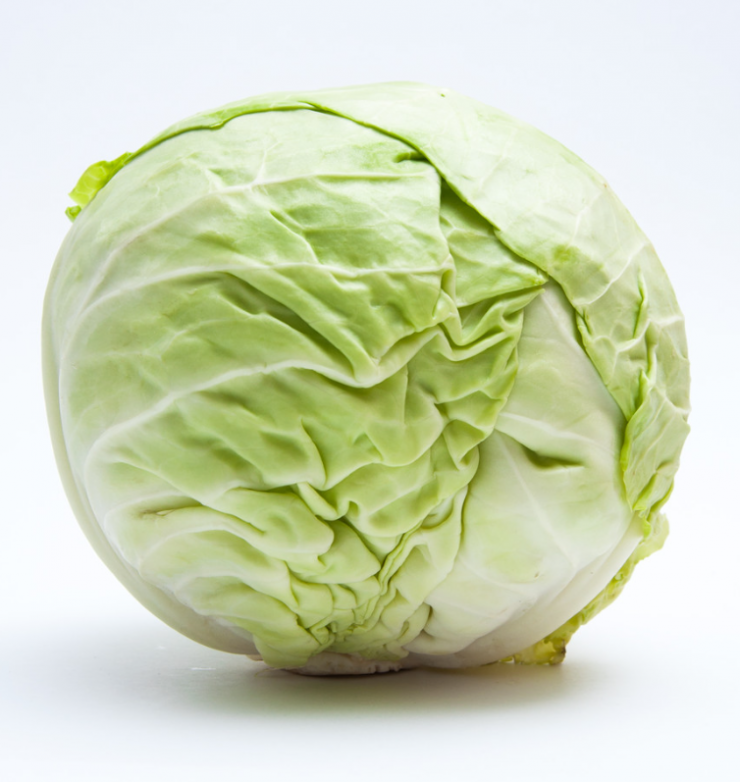
White Cabbage is also used to make Coleslaw, and Saurkraut. This Cabbage can be stewed to make a traditional Dish of France called the 'Garbure'. It is a thick Stew for the colder months of the year which also use Goose Fat or Confit d'Oie and Ham. This Veg is perfect to use with any leftover after Christmas time but also right and ripe in season.
Another Winter Vegetable is Chicory also called Endive. It is slightly bitter and the leaves have bite and a crunchiness to them. They are often used in Salads. They do pair well with other Ingredients to balance a Dish for their taste and Texture. A nice Wintery Salad can be composed with the Endive using them along with Pears (or Apple), Blue Cheese ( either Stilton, Saint Agur, Roquefort etc...), pieces of Walnuts (or Hazelnuts), and shredded Savoy Cabbage (Another Winter Cabbage in season in December). Dressed with a Grain Mustard Vinaigrette, not only it is a pleasure to eat, this Salad apart from being seasonal makes good use of what can be left over from the Festive time, aka the Cheese from the Cheese Board presented at some point during December, or the Nuts that were on offer in a bowl but were not eaten.
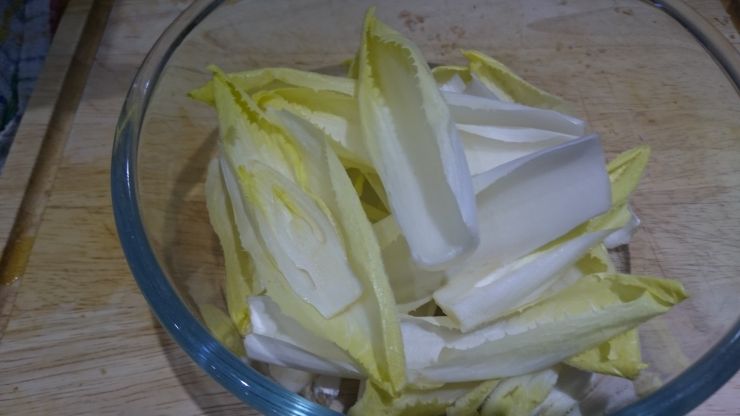
The crispy leaves of Endives can also be useful as little boat/recipient for home made Canapés. There your creativity is key. In the Festive Season they present a nice alternative to crackers or else blinis etc... You can also make them Vegan or Veggie friendly which is a plus. You just have to think of the content they will hold like a little treasure trove for your guests.
Chicory is very versatile as a Veg. My Mum used to do a very French and comforting Dish with Endives. It is traditional but there are always variations with recipes, they do evolve like people and nature do. I will only take the obvious exemple of the Tarte Tatin which was created by a simple mistake. Now the Dish with Endives can be classified, I think, as a deep Tray Bake or a Gratin. It is fit for Winter, but also cheep and cheerful. It consists of all of the Endives being wrapped with Ham then to be covered by Bechamel Sauce and like a Gratin being finished off with gratted Cheese, like Gruyére ( Emmental or Cheddar). It does require a little prep, like removing the core of the Endive at its base which looks like a little cone because this is a very bitter part which you can discard in a compost bin. Part boiling the Endives is recommended with ten minutes doing the trick before wrapping them with the Ham (Thick rather than thin) and placing them in the dish, cover them with the Sauce and the Cheese to then cook them in the oven. With a pinch of Nutmeg in the Bechamel Sauce you will have perfect comfort food under way.
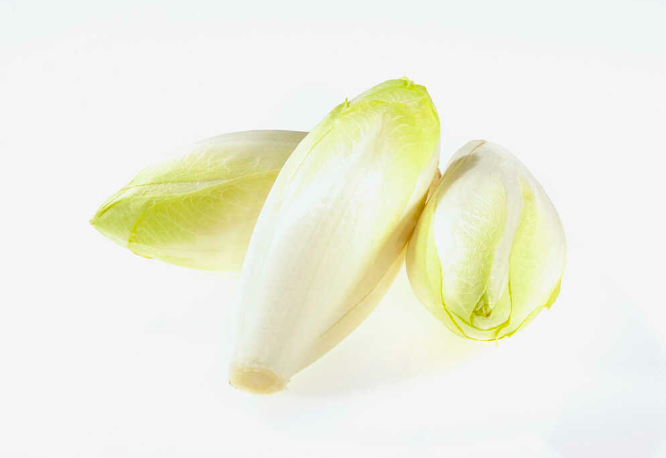
Chicory comes in two colours mainly: One with green tips and the other type with dark ruby coloured tips. Either way it is a Vegetable that must be tried and enjoyed. I came across a recipe which uses Chicory in a savoury Tart, which was upside down like the Tart Tatin one. It does caramelised the Chicory to a glorious delight.
And of course you can make an excellent Wintery Salad with Endives Leaves, using quartered and deseeded Pears, some Walnuts Halves, and Blue Cheese of your choice. A hanful of Rocket Leaves can, cut or crunched in little pieces add to the pepperiness of the Dish. The Salad can be all topped by an Ancient Mustard or a Grain Mustard Vinaigrette.
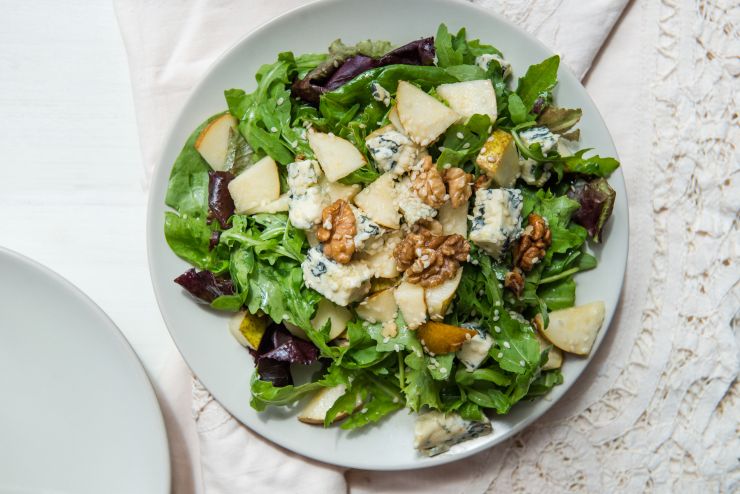
Who said that Salads were only appreciated during the sunny days. Indeed they can be enjoyed all year round using seanable Ingredients.
Then in Winter you do have what is called the 'Trinity' of Veg which are at their prime but nonetheless, nowadays those Veg are available at every time. It consists of Carrots, Leeks or/and Onions, and Celery. Together this trio of Veg makes a brilliant and flavourful combination for Stews, Casseroles, Soups and Stocks. It is just about giving flavour to the Dish you are preparing then to let the Veg simmer together.
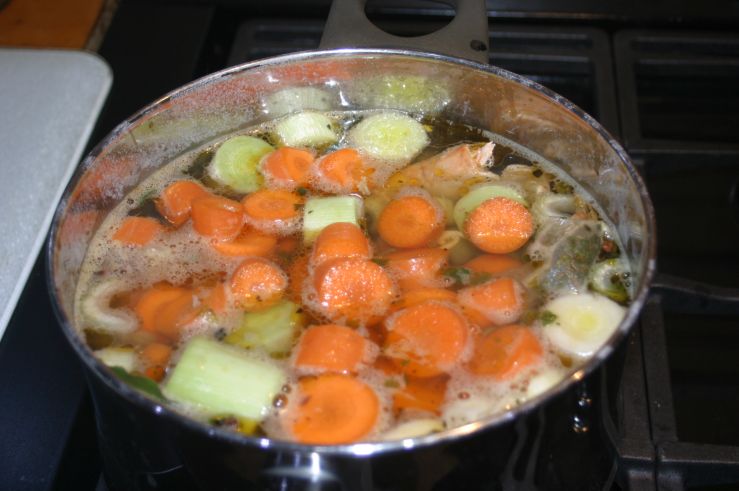
The base of a Stock: Carrots, Leeks and Celery. Then you can add any other ingredients to what you want your Stock to be, Chicken Stock, Fish Stock... etc.
I mentionned Carrots beforehand and picking apart those three seasonal Vegetables in Winter, I would say that Carrots are one of my favourites. Their versatility has a big part to play with it. Raw or cooked, they can be eaten in either ways which is a plus. During the cold months of the year, I like to braise the Carrots in Butter with a little dash of Garlic flavoured Olive Oil. Pealed, and cut length way before they hit the pan, however, I do slice them then quarter nowadays. The Spices are essential to flavour this Side Dish of Carrots. I use Cumin Seeds but also Caraway ones. A little Criander powder during cooking doesn't go amiss nor chopped Coriander Leaves for decoration but also taste at the end. A chopped Shallot at the start never hurt that Carrot Side Dish. Season to taste: Cracked Black Peppercorn with the optional Chilli Flakes. Take it to another level by adding some Stock, a small amount to be reduced down. It will render the Carrots to reach a tender softness. You can add a splash of Sherry if you wish to make it more Festive as a side. Then come the addition of the sweet element which could be either Honey or Mapple Syrup. I would recommand Heather Honey for this Dish. But also the addition of Herbs, the common pair of Rosemary and Thyme, finely chopped. This almost caramelised Carrot Side is full of flavour.
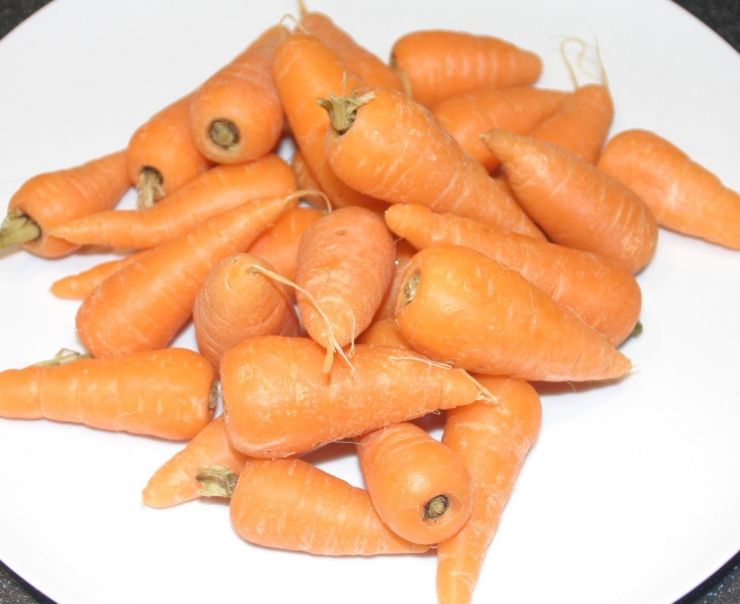
Little Chantenay Carrots. Those are sweet therefore so nice to use with that side Dish. It does rend it dainty. Now for quirkyness Rainbow Carrots could give a good colourful Dish but also a good talking point at the table when you know that we use nowadays mostly orange Carrots since the 16th century, since they were created by the Dutch, who are excellent Horticulteurs and Agriculteurs, in hommage to William of Orange who married the Queen of England of the time Mary the II.
Another Winter Veg is Leek, however it can be grown all year round. There is a magical simple trick which is to cut the base of a shop bought Leek, which have a tiny bits of roots. Put that bottom bit in Water to watch another Leek sproot out of that base. It is quite mesmerising to witness and ever so simple to do. As soon as the green straight leaves appear on the top and reach about five centimetres high then you can plant that future Leek in the ground or in a pot. Check that you have a decent root system before you do so. But this experiment will teach you to have a Leek, eat it, and make it come again. This is a tip worth knowing.
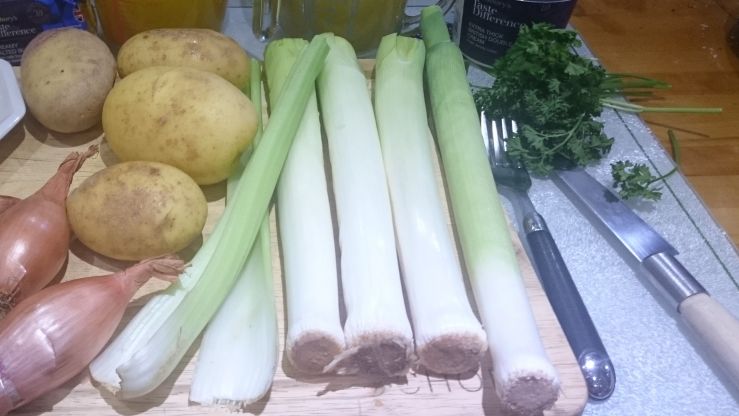
The base of a Leek can make another Leek so you can keep it rather than discarding it. You will have more chance to do so with the ones that still have a little bit of roots at the bottom. A Leek is a come again Veg.
Leeks which is part of the Allium Family has been a culinary staple food for a very long time. Most of us are familiar with the Leek and Potato Soup. I used to dislike it as a Child because I did find it stringy and I did blame it all on the Leeks rather than my Mum. No smile on that one, but if you can do that soup the Mary Berry way, you will have a treat all the way. It is made with Dolcelatte which give it the Va Va Voom and makes you want to sing 'When your eyes see the Moon like a big pizza pie that's Amore'...
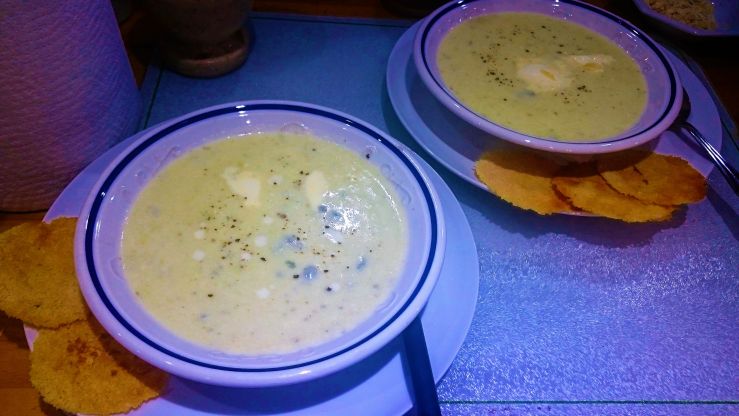
The Soup, Dolcelatte (a mild Italian Blue Cheese), Potato and Leek Soup is served with Parmesan Crisps. This Soup, following Mary Berry's recipe is delicious. It can warm up a Winter night.
To carry on upon Leeks, their flavour add to a Dish, a boost, like if it has been going through a lift. Thinking of other Winter Vegetables but also of good combinations between Veg, Leeks go very well with many. Thinking of Comfort Food, Pies do spring to mind especially when the weather is cold. Leeks and Celeriacs are similar to the combination of Leeks and Potatoes. It does just work together.
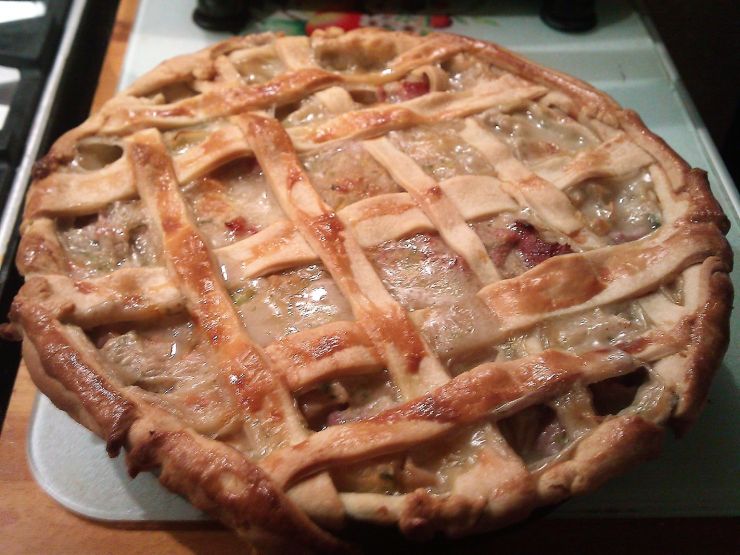
Pork, Celeriac and Leek Lattice Pie. This is a Winter Warmer.
In terms of Leeks, you have also a very good Starter Dish which is nowadays mainly done with Baby Leeks. The start is to prepare the Baby Leeks, a gentle trim, then to place them in a pan with either some little salted Water or even some little Veg Stock. It doesn't take long, one to three minutes maximum depending on the size of the Leeks. They drain them and pat them dry, There is a step then which is to let them marinate a little White Wine Vinaigar. Not too long either, it is just to give them that little kick of flavour. During that time chopped some Hazelnuts and Parsley but also put a griddle pan on with a tiny bit of Salted butter or not: your Choice. When the temperature is right, griddle your Baby Leeks to give them the lovely marks. Place them on a dish, I prefer oval ones in that case, but also in a disposition which is along side each other neatly. Add your toasted Hazelnuts on top, then a very light White Wine and Mustard Vinaigrette. Top with your chopped Parsley. Optional but more traditional, chopped hard boiled Eggs can be used instead of the Hazelnuts, to top the Leeks. (for People allergic to Nuts it is a way to go). And instead of hard boiled Eggs you can use a poached Egg.
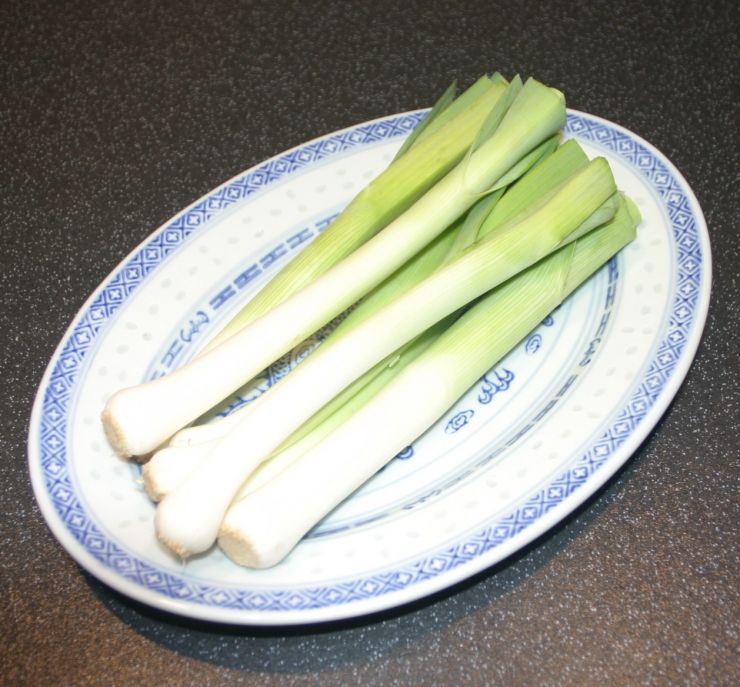
To stay with the 'Trinity' of Veg, lets talk about the humble Celery which can also be eaten either raw or cooked like a Carrot can. Celery like Leeks and Carrots usually never take centre stage in a Dish, they usually compliment it, add to it, as per say. They are in season in Winter, which is a good thing because this is when we need Celery the most for Stews, Stocks and Soups. Celery can be an acquired taste, of course, like Leeks somewhat it can feel stringy. I do love Celery in a different sort of way and mainly in a Summer to make a Veg platter surrounding a Dip or a trio Dips, they are indeniably part of it.
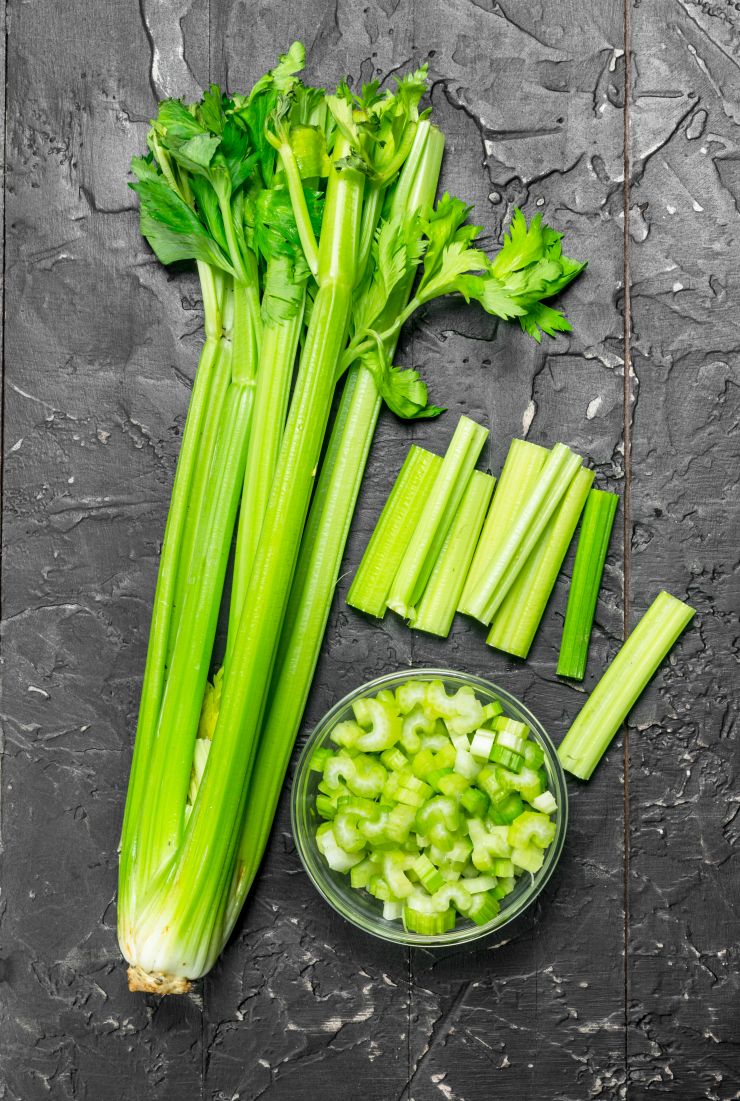
In that case, you will do the nicely slice batons of Celery to use for the Dip. Trimmed and all. But let me tell you something, you can also use them to dip in a Fondue Bourguignone Fondue or even a Cheese Swiss one...
If we return to Soups, Celery makes a perfect Ingredient for it. The advantage of it, is that is that it not only absolutly delicious, but also that you can also utilise the Fronts of it like a decoration in the same way one can do with Parsley for they are perfectly edible.
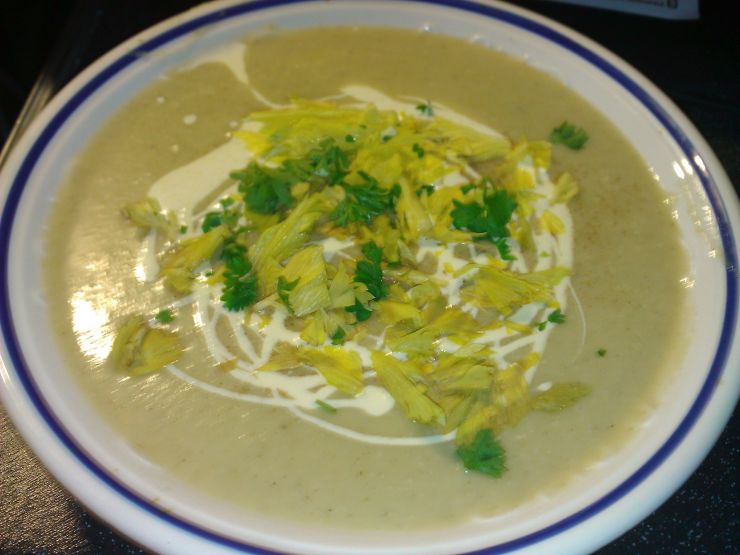
Home Made Creamy Celery Soup decorated with Celery Fronts and Parsley. It is a little number for the Winter.
In the Allium family we mentioned the Leek, but also in full season during the cold days are Shallots. They are different varieties of Shallots from Banana Shallots which are long, Echalion Shallots, and the little Pearl, round variety. They are also two types which are classified as pink or grey depending of their outside and inside colour after peeling them. Now, the taste of a Shallot is milder but also sweeter than the one of an Onion. Let us just say they are more delicate and refined in taste therefore you will find them more within Restaurant's Dishes.
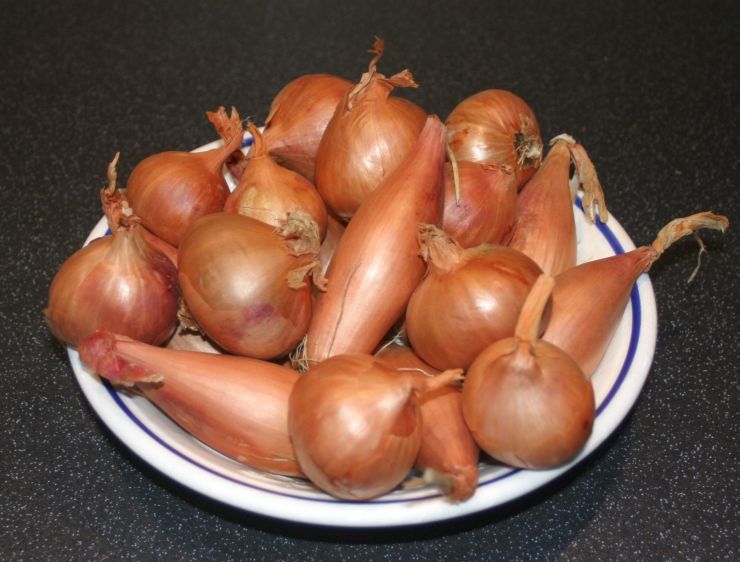
Some different shapes of Shallots. I love keeping a bowl of them in the Kitchen, I find it handy whenever I need one to cook something.
The Shallots being smaller than its conterpart the Onion tend to be chopped more finely. Therefore it suits many dishes like for exemple the Moules Mariniere, that typical French Dish which includes Mussels, Shallots, Garlic, Cream, Herbs and sometimes White Wine.
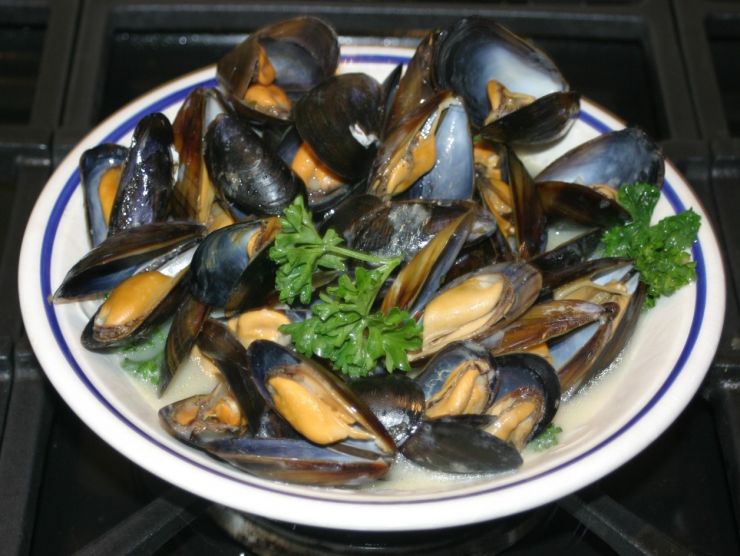
Moules Marinieres.
Shallots are also perfect to enhance Sauces like a good Béarnaise Sauce. In fact there are an intrisic part of it as much as Tarragon is. Otherwise you will just end up with a Hollandaise Sauce. Apart from Sauces, you can use Shallots instead of Onions in order to create a more refined Gravy which can be more elevated than Bangers and Mash with an Onion Gravy. There with Shallots you can be more elegant upon a plate. Because Shallots do pair well with different Wines from White to Red or stronger ones. This means that a Shallot Gravy can go with Beef, Lamb or Venison.
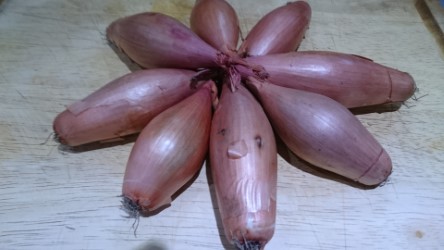
Shallots can be the Star of the Dish Show because they have plenty within their repertoire.
We must not forget that Shallots can be roasted, braised but also caramelised. It can give a boost to a Dish or side Dish. During the Festive period, pealed and caramelised round Shallots can be added to Brussel Sprouts (another Winter Veg) with some Lardons and a dash of Pommeau. (Pommeau which have the sweetness of Port, it is a stronger wine made from Apples, but it is less strong than Calvados.). The option of making a caramelised Echalion Tart Tatin, can be a Starter or a Dinner to remember.
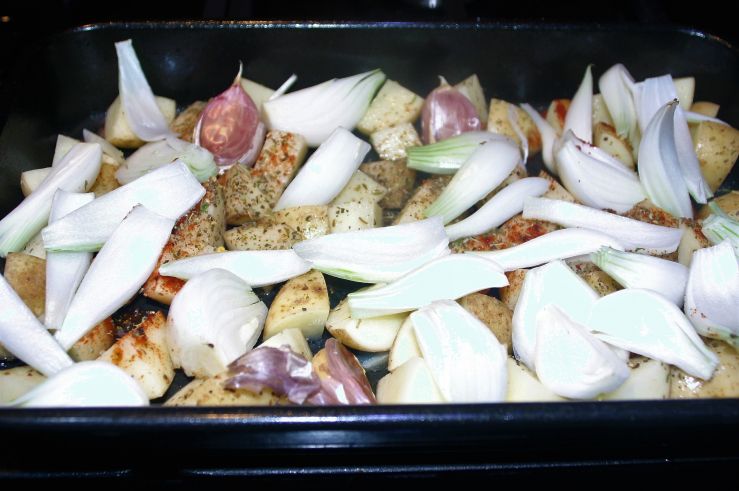
Roasted Shallots with added quartered Potatoes, and crushed Garlic. With a little smoked Paprika and dried Thyme, it is very nice to accompany white Meat like Chicken or Pork. The optional addition of sliced Chorizo can give that dish a Spanish feel.
Shallots like Onions are perfect for Soups but they are more subtle in flavour hence they can give another Ingredient the limelight to be centre. A lovely Soup for Winter is a Creamy Butternut Squash and Shallots one. With the addition of a little Ginger, it is a warming number for the cold days. This brings us to another seasonal Veg or may I say other Vegetables which are available in Winter and do last fairly long, the Squashes.
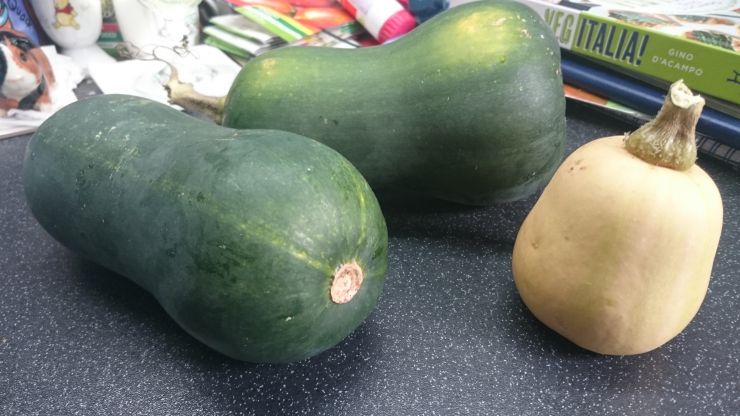
Butternut Squashes from my Garden which didn't reach the ripe stage in October.
Frankly I do love Butternut Squash. We do grow them once in a while, we do love having them on our plates to just enjoy. My favourite is of course another Soup with Butternut Squash, however I do love roasted Butternut Squash as well. To do a Purée with Butternut Squash is more difficult to pair with other Ingredients on a plate but it can be sucessfully done. Spices like Cinnamon, Garlic, Peppercorn or Ginger can lift that Purée to a next level to prevent it to be overly sweet.
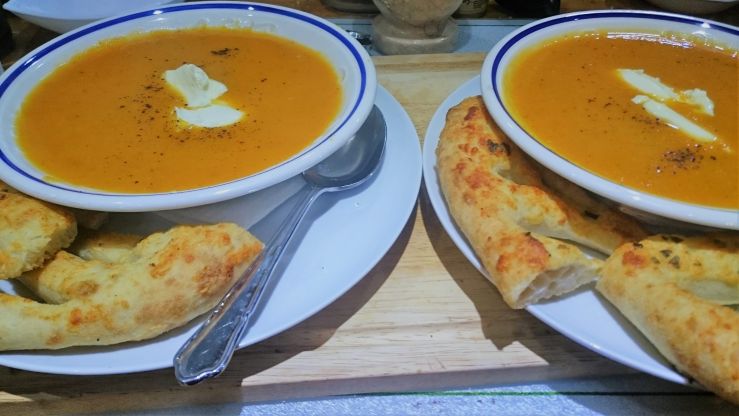
Butternut Squash and Orange Soup served with a herby Fougasse Bread.
Pasta can be an excellent medium to use Butternut Squash. Either filled with the Purée of Butternut Squash like Tortellini or Ravioli, either used to make Lasagna Sheets with it. Butternut Squash pairs well with Sage but also Cubetti di Pancetta or Lardons. Therefore the scope is huge concerning Butternut Squash and Pasta.
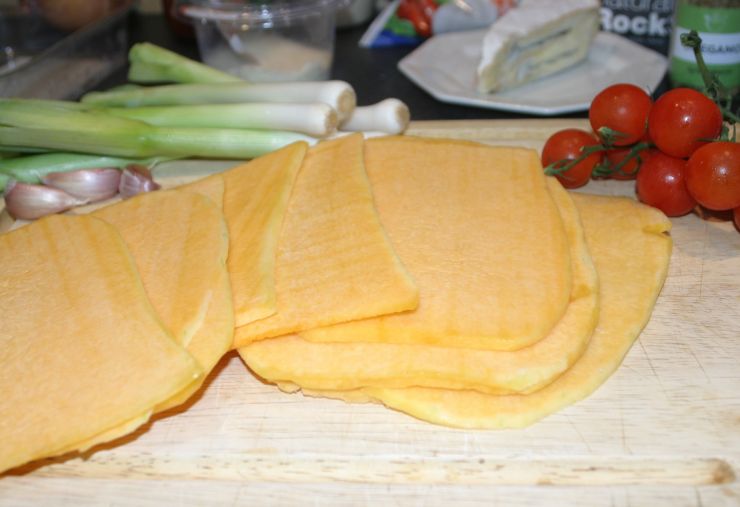
Butternut Squash Lasagna Sheets. They can be useful for everyone for they are Gluten free, and perfect for Veggies.
